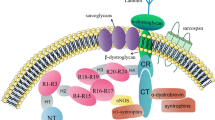Abstract.
New approaches to understanding and designing treatments for Duchenne muscular dystrophy (DMD) may emerge from two hypotheses outlined here. The proposal that growing skeletal muscle is more susceptible to necrosis than adult muscle raises the possibility that less intensive treatments may be sufficient to protect muscles during the adult phase. The second proposal is that a different balance of cell and molecular events contributes to acute necrosis (e.g. resulting from exercise) compared with chronic damage of dystrophic muscle. Validation of such differences presents the potential for more specific targeting of drugs or nutritional interventions to events downstream of the dystrophin deficiency. A deeper understanding of the events arising as an early consequence of dystrophin deficiency in these two situations may strengthen approaches to therapy for DMD designed to improve muscle function and the quality of life.
Similar content being viewed by others
Author information
Authors and Affiliations
Corresponding author
Additional information
Received 18 December 2007; received after revision 9 January 2008; accepted 25 February 2008
Rights and permissions
About this article
Cite this article
Grounds, M.D. Two-tiered hypotheses for Duchenne muscular dystrophy. Cell. Mol. Life Sci. 65, 1621–1625 (2008). https://doi.org/10.1007/s00018-008-7574-8
Published:
Issue Date:
DOI: https://doi.org/10.1007/s00018-008-7574-8




